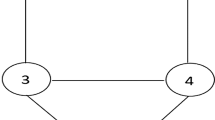Abstract
Quantum walks have been useful for designing quantum algorithms that outperform their classical versions for a variety of search problems. Most of the papers, however, consider a search space containing a single marked element. We show that if the search space contains more than one marked element, their placement may drastically affect the performance of the search. More specifically, we study search by quantum walks on general graphs and show a wide class of configurations of marked vertices, for which search by quantum walk needs Ω(N) steps, that is, it has no speed-up over the classical exhaustive search. The demonstrated configurations occur for certain placements of two or more adjacent marked vertices. The analysis is done for the two-dimensional grid and hypercube, and then is generalized for any graph.
Additionally, we consider an algorithmic application of the found effect. We investigate a problem of detection of a perfect matching in a bipartite graph. We use the found effect as an algorithmic building block and construct quantum algorithm which, for a specific class of graphs, outperforms its classical analogs.
Similar content being viewed by others
References
M. A. Nielsen and I. L. Chuang, Quantum Computation and Quantum Information (Cambridge Univ. Press, Cambridge, 2010).
A. Ambainis, “Understanding quantum algorithms via query complexity,” arXiv:1712.06349 (2017).
A. C. C. Say and A. Yakaryilmaz, “Quantum finite automata: a modern introduction,” Lect. Notes Comput. Sci. 8808, 208–222(2014).
R. de Wolf, “Quantum computing and communication complexity,” PhD Thesis (Univ.Amsterdam, Amsterdam, 2001).
S. Jordan, Quantum Algorithms Zoo. https://math.nist.gov/quantum/zoo.
R. Portugal, Quantum Walks and Search Algorithms (Springer, New York, 2013).
Y. Aharonov, L. Davidovich, and N. Zagury, “Quantum random walks,” Phys.Rev.A 48, 1687 (1993).
E. Farhi and S. Gutmann, “Quantum computation and decision trees,” Phys. Rev. A 58, 915 (1998).
N. Shenvi, J. Kempe, and K. B. Whaley, “A quantum random walk search algorithm,” Phys.Rev.A 67, 052307 (2003).
A. Ambainis, J. Kempe, and A. Rivosh, “Coins make quantum walks faster,” in Proceedings of SODA’05 (2005), pp. 1099–1108.
N. Nahimovs and A. Rivosh, “Exceptional configurations of quantum walks with Grover’s coin,” in Proceedings of MEMICS 2015 (2015), pp. 79–92.
T. H. Cormen, C. E. Leiserson, R. L. Rivest, and C. Stein, Introduction to Algorithms-Secund Edition (McGraw-Hill, New York, 2001).
F. Magniez, M. Santha, and M. Szegedy, “An O (n 1.3) quantum algorithm for the triangle problem,” in Proceedings of the Sixteenth Annual ACM-SIAM symposium on Discrete algorithms (SODA’05) (ACM-SIAM, New York-Philadelphia, 2005), pp. 413–424.
Author information
Authors and Affiliations
Corresponding authors
Additional information
The article was translated by the authors.
About this article
Cite this article
Nahimovs, N., Santos, R.A.M. & Khadiev, K.R. Adjacent Vertices Can be Hard to Find by Quantum Walks. MoscowUniv.Comput.Math.Cybern. 43, 32–39 (2019). https://doi.org/10.3103/S0278641919010060
Received:
Published:
Issue Date:
DOI: https://doi.org/10.3103/S0278641919010060




